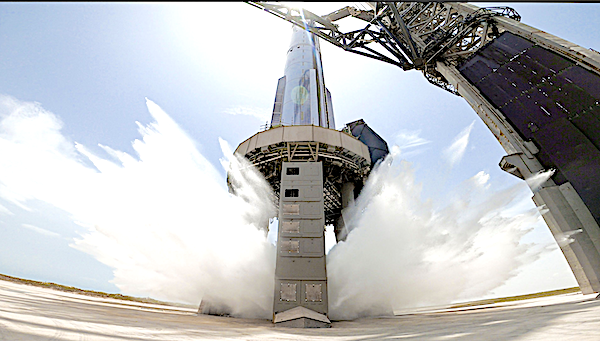
The seventh flight test of Starship and Super Heavy flew with ambitious goals, aiming to successfully repeat the core capability of returning and catching a booster while launching an upgraded design of the upper stage. While not every test objective was completed, the lessons learned will roll directly into future vehicles to make them more capable as Starship advances toward full and rapid reuse.
On January 16, 2025, Starship successfully lifted off at 4:37 p.m. CT from Starbase in Texas. At launch, all 33 Raptor engines on the Super Heavy booster started up successfully and completed a full duration burn during ascent. After powering down all but the three center engines on Super Heavy, Starship ignited all six of its Raptor engines to separate in a hot-staging maneuver and continue its ascent to space.
Following stage separation, Super Heavy initiated its boostback burn to propel the rocket toward its intended landing location. It successfully lit 12 of the 13 engines commanded to start, with a single Raptor on the middle ring safely aborting on startup due to a low-power condition in the igniter system. Raptor engines on upcoming flights have a pre-planned igniter upgrade to mitigate this issue. The boostback burn was completed successfully and sent Super Heavy back to the launch site for catch.

The booster successfully relit all 13 planned middle ring and center Raptor engines for its landing burn, including the engine that did not relight for boostback burn. The landing burn slowed the booster down and maneuvered it to the launch and catch tower arms at Starbase, resulting in the second ever successful catch of Super Heavy.
After vehicle separation, Starship’s six second stage Raptor engines powered the vehicle along its expected trajectory. Approximately two minutes into its burn, a flash was observed in the aft section of the vehicle near one of the Raptor vacuum engines. This aft section, commonly referred to as the attic, is an unpressurized area between the bottom of the liquid oxygen tank and the aft heatshield. Sensors in the attic detected a pressure rise indicative of a leak after the flash was seen.
Roughly two minutes later, another flash was observed followed by sustained fires in the attic. These eventually caused all but one of Starship’s engines to execute controlled shut down sequences and ultimately led to a loss of communication with the ship. Telemetry from the vehicle was last received just over eight minutes and 20 seconds into flight.
Contact with Starship was lost prior to triggering any destruct rules for its Autonomous Flight Safety System, which was fully healthy when communication was lost. The vehicle was observed to break apart approximately three minutes after loss of contact during descent. Post-flight analysis indicates that the safety system did trigger autonomously, and breakup occurred within Flight Termination System expectations.
The most probable root cause for the loss of ship was identified as a harmonic response several times stronger in flight than had been seen during testing, which led to increased stress on hardware in the propulsion system. The subsequent propellant leaks exceeded the venting capability of the ship’s attic area and resulted in sustained fires.
Immediately following the anomaly, the pre-coordinated response plan developed by SpaceX, the FAA, and ATO (air traffic control) went into effect. All debris came down within the pre-planned Debris Response Area, and there were no hazardous materials present in the debris and no significant impacts expected to occur to marine species or water quality. SpaceX reached out immediately to the government of Turks and Caicos and worked with them and the United Kingdom to coordinate recovery and cleanup efforts. While an early end to the flight test is never a desired outcome, the measures put in place ahead of launch demonstrated their ability to keep the public safe.
SpaceX led the investigation efforts with oversight from the FAA and participation from NASA, the National Transportation Safety Board, and the U.S. Space Force. SpaceX is working with the FAA to either close the mishap investigation or receive a flight safety determination, along with working on a license authorization to enable its next flight of Starship.
As part of the investigation, an extended duration static fire was completed with the Starship flying on the eighth flight test. The 60-second firing was used to test multiple engine thrust levels and three separate hardware configurations in the Raptor vacuum engine feedlines to recreate and address the harmonic response seen during Flight 7. Findings from the static fire informed hardware changes to the fuel feedlines to vacuum engines, adjustments to propellant temperatures, and a new operating thrust target that will be used on the upcoming flight test.
To address flammability potential in the attic section on Starship, additional vents and a new purge system utilizing gaseous nitrogen are being added to the current generation of ships to make the area more robust to propellant leakage. Future upgrades to Starship will introduce the Raptor 3 engine, reducing the attic volume and eliminating the majority of joints that can leak into this volume.
Starship’s seventh flight test was a reminder that developmental progress is not always linear, and putting flight hardware in a flight environment is the fastest way to demonstrate how thousands of distinct parts come together to reach space. Upcoming flights will continue to target ambitious goals in the pursuit of full and rapid reusability.
